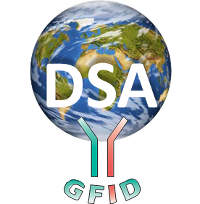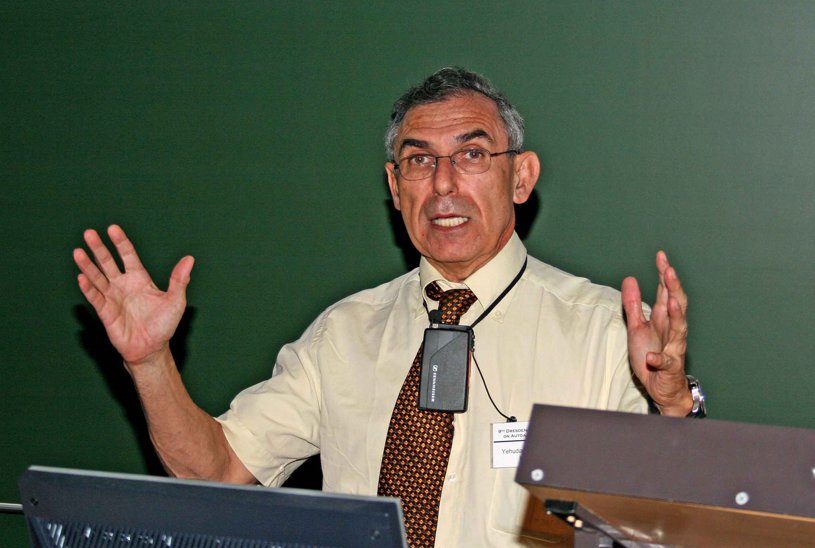
Dresden, September 9 - 12, 2025
8th International Consensus on ANA Pattern (ICAP) and Workshop on Harmonization of Autoantibody Detection
Dresden, September 8, 2025 Congress venue: Dresden Fair (Messe Dresden, Messering 6, 01067 Dresden, Germany)
| DSA 2025 | Congress Information | Registration | Programme | Abstract Submission |
Sponsorship
and Industrial Exhibition |
Tourist Information |
| Welcome |
| DSA
History |
| DSA Archive |
| Related Events |
| DSA History |
|
A SHORT HISTORY OF DRESDEN SYMPOSIA ON AUTOANTIBODIES The 17th Dresden Symposium is the occasion for a short reminiscence: In 1990, we realized the First Dresden Symposium on Autoantibodies, just one week after the re-unification of Germany. Clinicians and scientists from the Eastern and the Western part of Germany, Austria and Luxembourg discussed mainly methodical aspects of autoantibody determinations but also the clinical and pathogenic relevance of autoantibodies. The topics of the Second Symposium in April 1993 dealed mainly with diagnostic aspects. The Third Symposium in September 1996 was a turning point in such a way that we realized the first international meeting with participants from 14 countries. The series of international symposia was not possible without the active help of the co-chairs and members of the international advisory committee as well as the members of national organizing committee. It was a happenstance that the support of three international opinion leaders in the field of autoantibody research, René Luis Humbel (Luxembourg), Eng M. Tan (La Jolla, USA) and Yehuda Shoenfeld (Tel-Hashomer, Israel) led to the successful start and continuation of our international symposia since 1996. Equally, the other co-chairs of the following symposia, Michael Meurer (Dresden, Germany), Marvin Fritzler (Calgary, Canada), Michael Bachmann (Dresden, Germany), Edward K. L. Chan (Gainesville, USA), Allan Wiik (Copenhagen, Denmark), Philipp von Landenberg (Olten, Switzerland), Luis E. C. Andrade (Sao Paulo, Brazil), Pier Luigi Meroni (Milan, Italy), Ger J. M. Pruijn (Nijmegen, The Netherlands), Günter Steiner (Vienna, Austria) had a key role in the organization and in the succes of these meetings.   The "founders" of the international series Dresden Symposia of Autoantibodies. Left: Eng M. Tan, René Louis Humbel and Karsten Conrad in discussion at the 5th Symposium 2000; Right: Yehuda Shoenfeld in action at the 9th Symposium 2009.
Topics and Speakers The
main
purpose of the Dresden Symposia is to provide a podium
for clinicians and scientists specialised in
"autoimmunology" to exchange academic informations and
to present and discuss the results of basic and applied
research on autoantigens, autoantibodies and
autoimmunity. Besides methodical aspects of autoantibody
determinations and diagnostic strategies for autoimmune
diseases the autoantibody symposia focused on various
aspects of the induction, pathogenicity and clinical
relevance of autoantibodies. Furthermore, each symposium
had its own main focus: Pathogenic idiotypes, silica
exposure and autoimmunity (3rd
Symposium, 1996); Autoantibodies and tumors (4th
Symposium, 1998); Autoantigens - structure,
function and role in the pathogenesis of autoimmune
diseases (5th Symposium, 2000); From proteomics
to molecular epidemiology: Relevance of autoantibodies (6th
Symposium, 2002); From animal models to human
genetics: Research on the induction and pathogenicity of
autoantibodies (7th Symposium, 2004); From
etiopathogenesis to the prediction of autoimmune
diseases: Relevance of autoantibodies (8th Symposium,
2007); From pathogenesis to therapy of
autoimmune diseases (9th Symposium, 2009). Our
anniversary event, the 10th Symposium, 2011
"From Prediction to Prevention of Autoimmune Diseases"
concentrated on different aspects of the pathogenesis,
the prediction, novel treatment regimes and prevention
of systemic and organ specific autoimmune diseases as
well as autoimmune graft rejections. The 11th
Symposium, 2013 entitled "Infections, Tumors
and Autoimmunity" focussed on manifold aspects of
autoimmunity in infections and tumors, novel aspects in
the pathogenesis of autoimmune diseases, paraneoplastic
and tumor associated autoantibodies, autoantibodies in
systemic autoimmune rheumatic and neurological diseases,
the standardization/harmonizationof autoimmune
diagnostics and other methodical aspects of autoantibody
testing.  
Pioneers of autoimmune research. Left: Noel R. Roes in discussion at the 8th Dresden Symposium on Autoantibodies 2007. Right: Walter van Venrooij talking at the 9th Symposium 2009. Up
to
now, clinicians and scientists from 44 countries, mainly
from Europe and North America, but also from South
America, Asia, Australia, New Zealand and North Africa,
attended the symposia to present and/or discuss various
aspects of the etiopathogenesis, diagnostics and therapy
of autoimmune diseases. Among these participants were
many young scientists but also pioneers of autoimmunity
research. So we are very proud that we could welcome
Noel R. Rose, Baltimore, USA (Witebsky-Rose criteria;
research on autoimmune thyroid diseases and
pathomechanism of autoimmune diseases), Eng M. Tan, La
Jolla, USA (1966: discovery of Sm antibodies together
with H.G. Kunkel; research on autoantibodies against
extractable nuclear antigens among others), Morris
Reichlin, Oklahoma City, USA (discovery and research on
Ro and La antibodies), Walther van Venrooij, Nijmegen,
The Netherlands (autoantibodies against citrullinated
proteins/peptides) and Angela Vincent, Oxford, UK (ion
channel antibodies), Josep Dalmau, Barcelona, Spain
(autoantibodies in encephalitis and paraneoplastic
neurological diseases), Kenneth Michael Pollard, La
Jolla, USA (environmental factors and autoimmunity), and
Jill P. Buyon, New York, USA (congenital heart block) to
one or more of our symposia. Equally, we highly
appreciate the contributions of all experts, who
presented their newest data during the symposia and who
are named in the programs of the past
symposia
published on "Programmes of
the past Symposia".  
Co-Chairs since the 6th and 7th Dresden Symposium on Autoantibodies, respectively. Left: Marvin J. Fritzler talking at the 8th Dresden Symposium on Autoantibodies 2007. Right: Edward K.L. Chan in discussion with Henri-André Ménard at the 9th Symposium 2009.
Organisation and Sponsorship The
organisational aspects including cultural programmes of
the symposia were performed by Blackwell GCM, Berlin,
Germany (1996), Porstmann Kongresse GmbH, Berlin,
Germany (1998), P & R Kongress GmbH, Berlin, Germany
(2000), and since 2004 by the Association for the
Advancement of Immune Diagnostics, Dresden, Germany
(founded during the 6th Symposium in 2002). Up to now,
more than 50 companies have participated in the
industrial exhibitions, among them some that are not
existing yet and others that were founded in the past
years. Representatively, we would like to mention the
following companies which were present eight times or
more often at the Dresden symposia: Bio-Rad Laboratories
(8); BioSystems S.A., Barcelona, Spain (8 times);
Medipan GmbH, Dahlewitz, Germany (9); DLD Diagnostika
GmbH, Hamburg, Germany (10); Elias/Pharmacia
diagnostics/Phadia GmbH, Freiburg, Germany (10);
IMTEC/HUMAN GmbH, Berlin/Wiesbaden, Germany (10); The
Binding Site GmbH, Schwetzingen, Germany (10); ORGENTEC
Diagnostika GmbH, Mainz, Germany (10); and EUROIMMUN
Medizinische Labordiagnostika AG, Lübeck, Germany (13).
Furthermore, the Dresden meetings were partially
sponsored by the DFG Deutsche Forschungsgemeinschaft
(Bonn, Germany) and the Medical Faculty of the Technical
University Dresden (Dresden, Germany). Herewith we thank
all sponsors that contributed essentially to the success
of the past symposia. Dresden Prize on the Study of Autoantibodies The
Dresden Prize on the Study of Autoantibodies was founded
by the Association for the Advancement of Immune
Diagnostics to award young scientists up to age 35 for
their contribution of outstanding results on the
research on autoantibodies presented at the Dresden
Symposia on Autoantibodies. The prize of 1000 EUR was
awarded for the first time in 2004 at the 7th Dresden
Symposium on Autoantibodies to Nikolina
Mihailova
& Elisaveta Voynova from the
Bulgarian Academy of Sciences, Sofia (Bulgaria). They
presented their results on the "Selective
suppression of DNA-specific
B cells in
lupus mice".
The second winner at the 8th Symposium (2007) was Joyce van Beers from
the Radboud University Nijmegen (The Netherlands) with
here results on "The synovial citrullinome of
rheumatoid arthritis patients". Her proteomics
analyses provided an inventory of synovial proteins in
the inflamed joints of rheumatoid arthritis (RA)
patients. Novel citrullinated proteins that may be
targeted by the immune system in the synovia of RA
patients were identified in synovial fluid samples of RA
patients. The winner of the 9th Symposium (2009), Klaartje Somers from
the Hasselt University Diepenbeek (Belgium), presented
her observations on "Novel autoantibody targets in
multiple sclerosis and rheumatoid
arthritis". By using
a cDNA phage display approach, Klaartje Somers et al.
identified novel autoantigenic targets of autoantibodies
in patients with multiple sclerosis and rheumatoid
arthritis (RA). Novel RA-specific autoantibodies that
are also present in rheumatoid factor and anti-CCP
negative patients with early RA may help to improve
early diagnosis, prediction and subtyping of RA.
Congress
Books and Autoantibody Guides Since
the 4th meeting (1998) special congress books comprising
review articles as well as abtracts of the active
participants were published at time of the Dresden
Symposia. We would like to thank all authors, especially
those who presented reviews of highly interesting topics
that were also discussed during the meeting. The title
of the first congress report was "Pathogenic and
diagnostic relevance of autoantibodies" (Pabst Science
Publishers, Lengerich 1998). In the following, a special
book series termed "Autoimmunity, Autoantigens,
Autoantibodies (AAA)" was introduced that includes also
Autoantibody Guides presented at the symposia (Contents
and exemplary excerpts please see at: http://www.gfid-ev.de/dsa-pastdsa.htm): · AAA Vol.10 (2015): From Autoantibody Research to Standardized Diagnostic Assays in the Management of Human Diseases. · AAA Vol. 11 (2017): Immunodeficiency, Infection and Autoimmune Diseases
Cultural
events
Each scientific meeting was accompanied by a special
event regarding culture and traditions of Dresden and
Surroundings. The Social Dinner of the 3rd Symposium
(the first international one) took place in the
historical restaurant "Italienisches Dörfchen" on the
Theatre Square, situated between the Semper Opera House,
the river Elbe, the Zwinger Museum and the Court Church.
At the 4th Symposium we visited "Pfunds Molkerei", the
most beautiful milk shop of the world (since 1998 in the
Guinness Book of Records). The cultural highlight of the
5th Symposium was the visit of the specialized
restaurant "Silberstollen" dedicated to the traditions
of mining in Saxony (unfortunately closed since the
great flood in 2002). Moritzburg Castle, the hunting
lodge and summer residence of August the Strong
(1670-1733) near Dresden was the event location of the
6th Symposium. Before the Social Dinner, a guided tour
through the baroque museum provided an insight into the
largest collection of ornamental leather tapestries in
the world, Saxon and French furniture, Oriental and
Meissen porcelain, paintings of the 17th and 18th
century and the most important collection of hunting
trophies in Europe. A guided tour to the Pillnitz Palace
and Park and Social Dinner in the historical Orangery of
the Pillnitz Palace highlighted the cultural part of the
7th Symposium. Pillnitz Castle, the former summer
residence of the Saxon royal court is today the home of
the Museum of Decorative Arts. The park deserves closer
attention as it combines the strict forms of the baroque
period with those of an English landscape garden.
Alongside many rare trees the over 200-year-old Japanese
camellia is a particular magnet for visitors.
  Dancing
with countess Cosel at Pillnitz Park.
During
the 12th Dresden Symposium (2015) we organised a guided
visit of the Dresden Castle or Royal Palace, former
residence of the kings of Saxony, today an
internationally renowned museum. In 2017 (13th Dresden
Symposium on Autoantibodies), we visited the world
famous Old Masters Picture Gallery. The following Dinner
in the Hilton Hotel was highlighted by the performance
of the world champion in fast drawing.
In
the next years we will attempt to continue the
successful series of Dresden Symposia on
Autoantibodies and we hope to welcome you at the 17th
Dresden Symposium on Autoantibodies in September of
2025.
|




